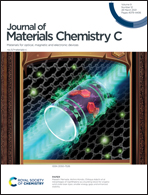Novel IV–V–VI semiconductors with ultralow lattice thermal conductivity†
Abstract
Crystalline solids with ultralow thermal conductivity are paramount for the development of thermoelectric materials and thermal barrier coatings for efficient thermal energy management. Here, by high-throughput ab initio calculations, we predict a group of 56 novel layered semiconducting IV–V–VI (IV = Si, Ge Sn, Pb; V = As, Sb, Bi; VI = S, Se, Te) compounds that are energetically, mechanically and dynamically stable. We demonstrate that these hitherto-unknown semiconductors exhibit intrinsically ultralow lattice thermal conductivity between 0.28 and 2.02 W m−1 K−1 at room temperature, most of which fall below 1 W m−1 K−1. Such ultralow thermal conductivity can be attributed to the presence of avoided-crossing behavior between low-lying optical phonons and acoustic modes, which leads to the significant reduction of phonon group velocities and induces ultrahigh Grüneisen parameters causing strong anharmonic phonon–phonon scattering, thus short phonon mean free path and low κl. In addition, we reveal that these IV–V–VI compounds show significant anisotropy κl along different directions, arising from the anisotropic group velocity and anharmonicity due to the weak VI–VI interlayer interactions along the c-axis. Our work not only provides a large family of novel semiconductors with exceptionally low κl but also highlights the design of new low-κl materials.



 Please wait while we load your content...
Please wait while we load your content...